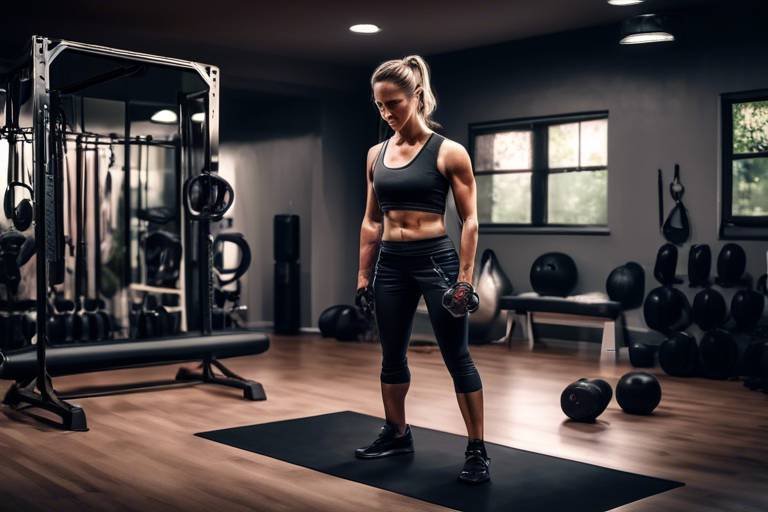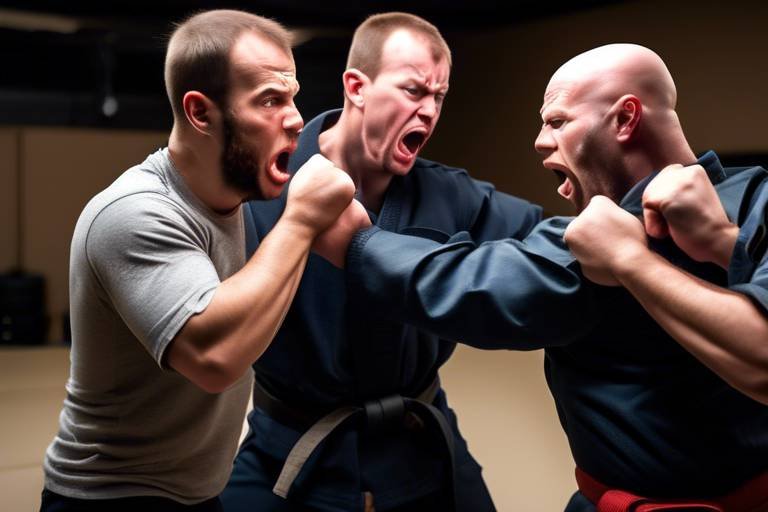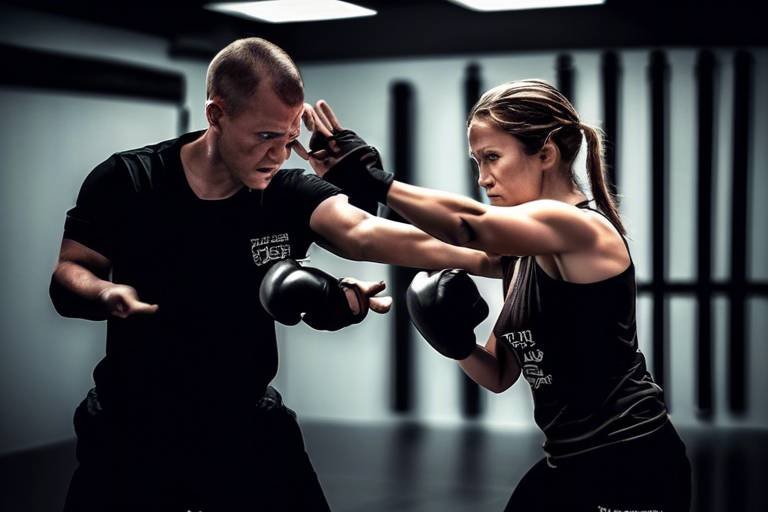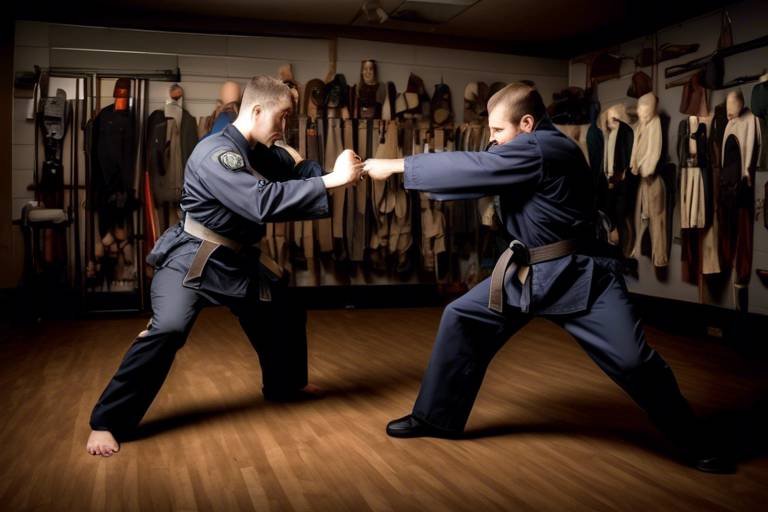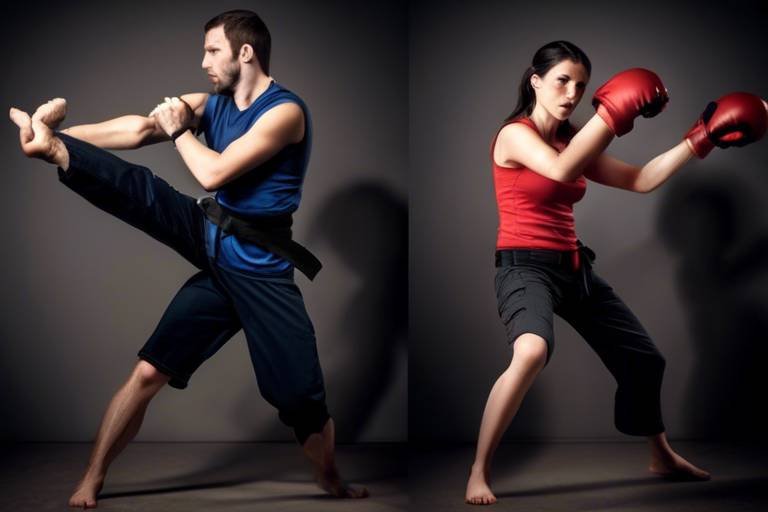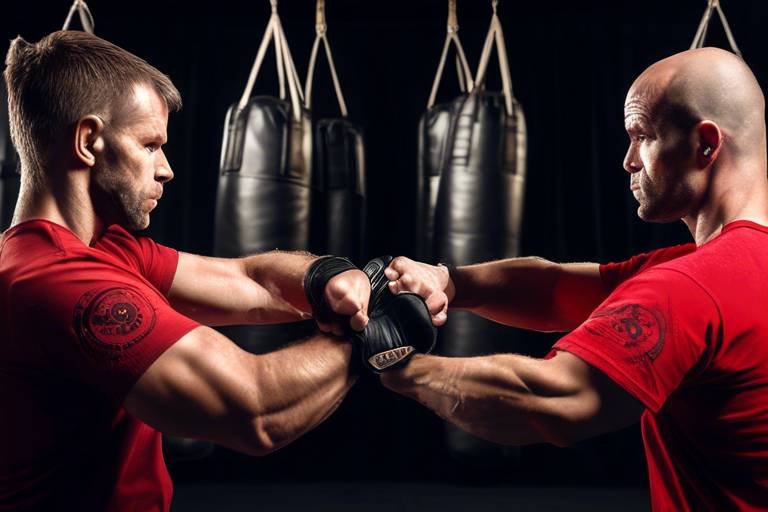How to Equip Your Home Gym for Better Self-Defense Training?
In today’s world, having the ability to defend yourself is not just a luxury; it’s a necessity. Setting up a home gym specifically for self-defense training can be a game-changer in building your skills and confidence. Not only does it provide you with a dedicated space to practice, but it also allows you to train at your own pace and on your own schedule. Imagine stepping into your own space, surrounded by the right equipment, where you can unleash your potential and prepare for any situation that life may throw your way. This article explores essential equipment and strategies for setting up a home gym tailored for self-defense training, helping you enhance your skills and confidence in personal safety.
First things first: you need to pick the right space for your home gym. This isn’t just about finding a corner in your living room; it’s about creating an environment that motivates you to train hard. Think about factors like size, lighting, and ventilation. A larger space allows for more movement and equipment, while good lighting can boost your mood and focus. Ventilation is equally important—nobody wants to feel stuffy while practicing those high kicks! Ultimately, your training area should feel like a sanctuary where you can zone in and get serious about your self-defense skills.
Investing in the right tools can significantly improve your training. Think of your equipment as the foundation of your self-defense practice. Without the right gear, you might find it challenging to hone your skills effectively. Here are some must-have items to consider:
- Heavy Bags: These are crucial for striking practice. They help build power, improve technique, and provide a realistic target for punches and kicks.
- Mats: If you’re practicing grappling or ground techniques, mats are essential to prevent injuries.
- Protective Gear: Gloves, shin guards, and headgear are vital to ensure safe training while you practice self-defense techniques.
By equipping your gym with these essentials, you’re setting yourself up for success.
Heavy bags are a staple for striking practice. They not only help you build power but also improve your technique and provide a realistic target for punches and kicks. Imagine the satisfaction of landing a solid hit on a heavy bag, knowing that each strike is bringing you one step closer to mastering self-defense.
Different types of heavy bags cater to various training needs. Here’s a quick overview of the options available:
| Type of Heavy Bag | Best For |
|---|---|
| Traditional Bags | Power and technique training |
| Free-Standing Bags | Versatility and ease of use |
| Specialty Bags | Specific martial arts training |
Choosing the right type of heavy bag will depend on your personal training goals and the space you have available.
Proper installation of your heavy bag is vital for safety and effectiveness. Ensure secure mounting, consider height adjustments, and choose a suitable location to avoid damage and enhance your training experience. A well-installed heavy bag will not only withstand your powerful strikes but will also give you the confidence to train harder.
Wearing the right protective gear is essential for safe training. Self-defense training can get intense, and you’ll want to minimize injuries while practicing techniques. Options such as gloves, shin guards, and headgear are crucial. Think of them as your armor—protecting you while you sharpen your skills. Investing in quality gear can make a substantial difference in your training experience.
Functional training complements self-defense skills by improving strength, agility, and endurance. It’s about preparing your body for real-life scenarios where quick reactions and physical strength are necessary. Incorporate exercises that enhance your physical capabilities, such as:
- Bodyweight Exercises: Push-ups, squats, and lunges can help build a solid foundation for self-defense.
- Cardio Conditioning: Activities like jump rope, running, or high-intensity interval training (HIIT) can enhance your cardiovascular fitness.
By focusing on functional training, you’re not just building muscles; you’re building the kind of strength and endurance that will serve you well in real-life situations.
Establishing a consistent training schedule is key to progress. It’s easy to get sidetracked, but setting realistic goals and structuring your workouts can keep you on track. Think of your training like a recipe: you need the right ingredients and the right timing to create the perfect dish. Don’t forget to maintain motivation—whether it’s through setting personal milestones or finding a training buddy, keeping your spirits high will ensure continuous improvement in your self-defense skills.
1. How much space do I need for a home gym?
The amount of space needed can vary based on the equipment you choose, but a small area (like a spare room or garage corner) can work well for basic training.
2. What is the best equipment for beginners?
For beginners, a heavy bag, a good pair of gloves, and a mat are excellent starting points.
3. How often should I train?
Aim for at least 2-3 times a week to see significant improvements in your skills and fitness.

Choosing the Right Space
When it comes to setting up your home gym for self-defense training, is absolutely crucial. Imagine trying to practice your moves in a cramped, cluttered room—it's not just challenging; it can also be dangerous! You want a space that inspires focus and motivation, so let’s break down the key factors to consider.
First off, think about the size of the area. Ideally, you should have enough room to move around freely, perform various exercises, and even practice your footwork without bumping into furniture or walls. A space that’s at least 10x10 feet can be a good starting point, but the more room you have, the better. This allows you to incorporate a variety of training equipment, from heavy bags to mats, without feeling cramped.
Next, let’s discuss lighting. A well-lit space can significantly enhance your training experience. Natural light is fantastic, but if that’s not an option, consider installing bright LED lights. Good lighting not only helps you see your surroundings better but also boosts your mood and energy levels. After all, who wants to train in a dim, dreary corner of their home?
Another factor to consider is ventilation. Training can get intense, and you’ll want to ensure that you have proper airflow to keep the space comfortable. If your chosen area has windows, great! Open them up to let in some fresh air. If not, think about investing in a fan or an air purifier to keep the environment pleasant and motivating.
Lastly, take a moment to assess the flooring. The surface you train on can make a world of difference. For instance, hardwood floors might be too hard on your joints, while carpet can be slippery and unsafe. Consider using interlocking foam mats or rubber flooring to provide cushioning and traction, making your training sessions safer and more effective.
In summary, the right space can elevate your self-defense training experience. Remember to consider size, lighting, ventilation, and flooring—these elements all contribute to creating an environment that fosters growth and safety. So, take the time to find or create a space that works for you, and you’ll be well on your way to mastering your self-defense skills!

Essential Equipment for Self-Defense
Investing in the right tools can significantly improve your training and boost your confidence when it comes to self-defense. Think of your home gym as your personal fortress, where you prepare not just your body but also your mind for any potential threats. The right equipment can turn your training sessions into a dynamic experience that sharpens your skills and enhances your readiness. So, what exactly should you include in your self-defense arsenal?
First and foremost, heavy bags are a must-have. These are not just any ordinary punching bags; they are your primary tool for striking practice. Imagine them as your opponent, allowing you to unleash your power and refine your technique. When you strike a heavy bag, you’re not just hitting a target; you're building muscle memory and learning how to deliver effective punches and kicks. Heavy bags come in various types, each serving a unique purpose, which we will explore in detail shortly.
Next up, let's talk about protective gear. Safety should always be your top priority, especially when you're practicing with intensity. Wearing the right gear—like gloves, shin guards, and headgear—can help minimize injuries and keep your training sessions productive. Think of protective gear as your safety net; it allows you to push your limits without the constant fear of getting hurt. Investing in quality protective gear not only enhances your training but also instills a sense of security, enabling you to focus on mastering your techniques.
Additionally, consider incorporating training mats into your setup. These mats provide a cushioned surface that can significantly reduce the risk of injury during falls or ground techniques. They create a safe environment for practicing grappling or any self-defense moves that involve going to the ground. Just like a soft landing pad for a skydiver, mats can make all the difference in your training comfort and safety.
Now, let’s not forget about resistance bands and weights. These tools are fantastic for building strength and enhancing your overall fitness, which is crucial for effective self-defense. With resistance bands, you can perform a variety of exercises that target different muscle groups, improving your agility and power. Weights, on the other hand, can help you build the kind of strength that translates directly into your striking and grappling techniques. Think of them as your secret weapons for conditioning.
To give you a clearer picture, here’s a quick overview of essential self-defense equipment:
| Equipment | Purpose |
|---|---|
| Heavy Bags | For striking practice and power building |
| Protective Gear | To minimize injuries during training |
| Training Mats | To provide a safe surface for grappling and falls |
| Resistance Bands | For strength training and flexibility |
| Weights | To build overall strength and conditioning |
In summary, the right equipment can elevate your self-defense training from basic drills to an engaging and effective workout. Whether you’re striking a heavy bag, donning your protective gear, or practicing on mats, each piece of equipment plays a vital role in your journey toward better self-defense skills. So, gear up, stay safe, and get ready to unleash your inner warrior!

Heavy Bags
When it comes to self-defense training, are an absolute game changer. They are not just a piece of equipment; they are your training partner, helping you hone your striking skills and build the kind of power that can make a real difference in a self-defense situation. Imagine the satisfying thud of your fist hitting the bag, the way it swings back at you, forcing you to react and adjust your technique. This kind of realistic practice is invaluable, and heavy bags provide the perfect platform for it.
Heavy bags come in various shapes and sizes, catering to different training needs and preferences. Whether you're looking to practice your punches, kicks, or even grappling techniques, there's a heavy bag out there for you. Here are some popular types:
- Traditional Heavy Bags: These are the classic, cylindrical bags that hang from a ceiling or stand. They are versatile and great for a variety of striking techniques.
- Free-Standing Bags: Ideal for those with limited space, these bags stand on a base and can be moved around easily. They are perfect for practicing kicks and punches without the need for installation.
- Specialty Bags: Designed for specific martial arts, these bags can help you focus on particular techniques, whether it’s Muay Thai elbows or boxing hooks.
Choosing the right heavy bag can significantly impact your training experience. For instance, a bag that is too light might not provide enough resistance to build power, while one that is too heavy could lead to improper technique and potential injuries. It’s essential to find a balance that complements your skill level and training goals.
Now, let’s talk about installation. Proper installation of your heavy bag is vital for both safety and effectiveness. You want to ensure that it’s securely mounted to withstand the force of your strikes. Here are a few tips:
- Choose the Right Location: Find a space with enough room to move around freely. You don't want to be bumping into furniture or walls while practicing.
- Height Adjustments: Make sure the bag is hung at a height that allows you to strike it comfortably, whether you're practicing jabs or high kicks.
- Secure Mounting: Use proper hardware to ensure that the bag won’t come crashing down during your training sessions. This not only protects your equipment but also keeps you safe.
In conclusion, heavy bags are an essential component of any self-defense training regimen. They allow you to practice striking techniques effectively while also building strength and endurance. Whether you opt for a traditional hanging bag or a free-standing model, the key is to use it consistently and incorporate it into your overall training plan. So go ahead, unleash your inner warrior, and let that heavy bag take your self-defense skills to the next level!

Types of Heavy Bags
When it comes to self-defense training, the type of heavy bag you choose can make a significant difference in your practice routine. Each type of heavy bag serves a unique purpose and caters to different training needs. Understanding these options will help you select the right one for your goals.
First up, we have the traditional heavy bag. These are the classic bags you often see in gyms, typically cylindrical in shape and filled with various materials to provide resistance. They are fantastic for practicing punches and kicks, allowing you to develop strength and technique. A traditional heavy bag is ideal for those looking to build power and improve striking accuracy. They come in various weights, so you can choose one that matches your fitness level and training intensity.
Next, let’s talk about free-standing bags. These bags are mounted on a base filled with water or sand, allowing them to stand upright without needing to be hung. The advantage here is that they can be easily moved around, making them perfect for those with limited space. Free-standing bags are excellent for practicing strikes at different angles and are particularly useful for beginners who want to work on their footwork and mobility.
Another option is the specialty heavy bag, designed for specific martial arts like Muay Thai or kickboxing. These bags often have unique shapes or are designed to mimic an opponent's body, helping you practice your strikes more realistically. For example, a banana bag is longer and allows for a more extensive range of kicking techniques, while a uppercut bag is specifically designed for practicing uppercuts and hooks. Choosing a specialty bag can greatly enhance your training by allowing you to focus on particular techniques.
| Type of Heavy Bag | Best For | Pros | Cons |
|---|---|---|---|
| Traditional Heavy Bag | Power and technique | Durable, versatile | Requires mounting |
| Free-standing Bag | Footwork and mobility | Portable, easy to use | Less stable for powerful strikes |
| Specialty Heavy Bag | Specific martial arts techniques | Realistic training | Can be expensive |
Ultimately, the choice of heavy bag should align with your training goals and available space. Whether you opt for a traditional bag, a free-standing option, or a specialty bag, each has its unique benefits that can enhance your self-defense training experience. So, take your time to weigh your options, and you'll be well on your way to mastering your self-defense skills!
Q: How do I know which heavy bag to choose?
A: Consider your training goals, available space, and budget. Traditional bags are great for power training, while free-standing bags offer flexibility. Specialty bags cater to specific techniques.
Q: Can I use a heavy bag for other workouts?
A: Absolutely! Heavy bags are versatile and can be used for various workouts, including cardio, strength training, and even stress relief.
Q: How do I maintain my heavy bag?
A: Regularly check for wear and tear, and keep it clean. If it’s a traditional bag, ensure it’s securely mounted. For free-standing bags, make sure the base is filled and stable.

Installation Tips
When it comes to installing your heavy bag, there are several important factors to consider to ensure safety and maximize your training experience. First and foremost, you need to choose the right location. Ideally, the bag should be installed in a spacious area where you have enough room to move around freely without any obstructions. Think of it as creating your own personal dojo; you want to feel comfortable and focused while training.
Next, secure mounting is crucial. If you're using a traditional hanging heavy bag, make sure to mount it to a solid beam or wall stud. This is not just a safety precaution; a well-secured bag will absorb your strikes better, allowing for a more effective workout. You don’t want to be in the middle of a powerful kick only to have the bag come crashing down, right? For those opting for free-standing bags, ensure the base is filled properly—often with sand or water—to prevent it from tipping over during use.
Height adjustments are another key consideration. The ideal height for your heavy bag depends on your training style and the techniques you want to practice. A good rule of thumb is to hang the bag so that the center is at your waist level. This height allows you to practice both low and high strikes effectively. If you’re taller or shorter than average, don't hesitate to adjust accordingly to suit your needs.
Finally, think about the flooring. If your training space has hard floors, consider placing a mat underneath the bag. Not only will this protect your flooring from damage, but it will also provide some cushioning for your feet, making your training sessions more comfortable. The right installation can make a world of difference, transforming your home gym into a safe and effective training ground.
- What type of heavy bag should I choose for self-defense training? It's best to choose a bag that fits your training style. Traditional hanging bags are great for striking, while free-standing bags offer flexibility in placement.
- How high should I hang my heavy bag? Ideally, the center of the bag should be at waist height, but adjust it based on your height and the techniques you want to practice.
- Can I install a heavy bag on drywall? It's not recommended to mount a heavy bag directly on drywall without proper reinforcements. Always secure it to a stud or beam for safety.
- What type of flooring is best for a home gym? A padded mat or rubber flooring is ideal as it provides cushioning and protects your joints during training.

Protective Gear
When it comes to self-defense training, one of the most important aspects to consider is . Just like a knight wouldn’t head into battle without armor, you shouldn’t step onto the training floor without the right equipment to keep you safe. Not only does protective gear help prevent injuries, but it also allows you to train with greater intensity and confidence. Imagine practicing your moves without the fear of getting hurt; that’s the freedom that proper gear provides!
Let’s dive into the essential pieces of protective gear you should consider for your home gym setup:
- Gloves: These are crucial for any striking practice. They protect your hands and wrists from injury while providing padding for your training partner. Look for gloves that offer a snug fit and sufficient padding to absorb the impact.
- Shin Guards: If you plan on practicing kicks, shin guards are a must-have. They shield your shins from bruises and cuts, allowing you to throw kicks freely without the worry of pain.
- Headgear: To protect your head during sparring sessions, headgear is essential. It minimizes the risk of concussions and other head injuries, making it easier to focus on your technique rather than your safety.
But it’s not just about having gear; it’s about having the right gear. Here’s a quick comparison of different types of protective gear to help you make informed choices:
| Type of Gear | Purpose | Recommended Brands |
|---|---|---|
| Gloves | Protects hands during striking | Everlast, Venum |
| Shin Guards | Protects shins during kicks | Fairtex, Hayabusa |
| Headgear | Protects head during sparring | RDX, Winning |
Before purchasing any gear, consider your training style and the specific techniques you’ll be practicing. For instance, if you’re focusing on Muay Thai, investing in high-quality shin guards becomes even more critical due to the emphasis on kicking. On the other hand, if you’re leaning towards boxing, a good pair of gloves is your best friend.
In addition to the gear mentioned, don’t overlook the importance of mouthguards and groin protectors. A mouthguard can prevent dental injuries during sparring, while a groin protector is essential for both men and women to guard against painful strikes. Always remember, safety first!
Ultimately, the right protective gear can make a world of difference in your training experience. It allows you to push your limits and hone your skills without the constant worry of injury. So, invest wisely, and you’ll find that your self-defense training becomes not only more effective but also more enjoyable.

Incorporating Functional Training
When it comes to self-defense, having the right techniques is crucial, but so is the physical capability to execute those techniques effectively. This is where functional training comes into play. It’s all about enhancing your body’s ability to perform real-life movements that you might encounter in self-defense situations. Imagine trying to escape from a hold or quickly getting back on your feet after a fall; these scenarios demand not just skill but also strength, agility, and endurance. By incorporating functional training into your home gym routine, you’re not only preparing your body for self-defense but also improving your overall fitness.
Functional training focuses on movements that mimic everyday activities. Think of it like preparing for a marathon, but instead of just running, you’re training your body to handle the unexpected twists and turns of an altercation. Exercises like burpees, box jumps, and kettlebell swings are fantastic for building the kind of strength and explosiveness that can make a difference in a self-defense scenario. Not to mention, they’re also a lot of fun!
To get the most out of your functional training, mix in a variety of exercises that target different muscle groups. This not only keeps your workouts interesting but also ensures a balanced approach to fitness. For example, you might choose to focus on:
- Upper Body Strength: Exercises like push-ups and pull-ups help build the strength needed for effective strikes.
- Lower Body Power: Squats and lunges develop the leg strength crucial for kicks and quick movements.
- Core Stability: Planks and Russian twists enhance your balance and control, vital for maintaining posture during a confrontation.
In addition, don’t underestimate the importance of cardio conditioning. Being able to outlast an opponent can be just as important as striking hard. Incorporate activities that get your heart pumping, like running or cycling, into your routine. High-intensity interval training (HIIT) is particularly effective, as it mimics the bursts of energy you might need in a self-defense situation. Picture yourself sprinting away from danger or quickly dodging an attack; that’s the kind of stamina you want to build.
To tie it all together, consider creating a training schedule that includes both strength and cardio workouts. For instance, you might dedicate certain days to strength training, focusing on functional movements, while reserving other days for cardio. This balanced approach will not only improve your self-defense skills but also keep you motivated and engaged in your training. Remember, consistency is key!
Q: How often should I incorporate functional training into my routine?
A: Aim for at least 2-3 times a week, mixing it with your self-defense practice for optimal results.
Q: Can I do functional training without any equipment?
A: Absolutely! Many bodyweight exercises are incredibly effective for functional training.
Q: What if I’m new to fitness?
A: Start slow! Focus on mastering basic movements and gradually increase intensity as you become more comfortable.

Bodyweight Exercises
When it comes to self-defense training, are not just beneficial; they are essential. These exercises utilize your own body weight as resistance, making them incredibly versatile and accessible. You can perform them anywhere, whether you're in your home gym or at the park. Think of bodyweight exercises as the bread and butter of your fitness regimen—they build strength, flexibility, and endurance without the need for fancy equipment. Plus, they are perfect for developing the functional strength required in real-life self-defense situations.
One of the most appealing aspects of bodyweight exercises is their adaptability to all fitness levels. Whether you're a beginner or a seasoned athlete, you can modify movements to suit your capabilities. For example, if a standard push-up feels too challenging at first, you can start with knee push-ups and work your way up. This gradual progression keeps you motivated and reduces the risk of injury—something that is crucial when you're practicing self-defense techniques.
Here are a few key bodyweight exercises that can significantly enhance your self-defense skills:
- Push-Ups: Great for building upper body strength, push-ups engage your chest, shoulders, and triceps, which are essential for powerful strikes.
- Squats: These target your legs and core, improving your overall stability and strength, which is vital for maintaining balance during a confrontation.
- Lunges: Lunges not only enhance leg strength but also improve your agility and coordination, allowing you to move swiftly in any direction.
- Planks: A fantastic core exercise, planks help you develop the core stability needed for effective self-defense maneuvers.
Incorporating these exercises into your training routine can lead to noticeable improvements in your physical capabilities. For instance, performing push-ups regularly can enhance your punching power, while squats can help you deliver stronger kicks. Moreover, these exercises can be performed in circuits, allowing you to get a full-body workout in a short amount of time. Imagine completing a series of push-ups, squats, and lunges back-to-back; not only will you build strength, but you’ll also boost your cardiovascular fitness.
To make the most of your bodyweight training, consider creating a structured routine. You might dedicate specific days to focus on different muscle groups or incorporate these exercises into your self-defense drills. Consistency is key; aim for at least three sessions a week. Over time, you’ll notice that your endurance increases, your movements become more fluid, and your confidence in your self-defense abilities skyrockets.
In conclusion, bodyweight exercises are a powerful tool in your self-defense training arsenal. They not only enhance your physical capabilities but also prepare you mentally for real-life scenarios. So, roll out that mat, find your rhythm, and start building a stronger, more confident you!
Q: How often should I perform bodyweight exercises for self-defense training?
A: Aim for at least three times a week, mixing in different exercises to target various muscle groups and keep your routine engaging.
Q: Can I do bodyweight exercises if I'm a beginner?
A: Absolutely! Bodyweight exercises can be modified to suit your fitness level, making them perfect for beginners. Start slow and gradually increase the intensity as you gain strength.
Q: Do I need a lot of space to perform bodyweight exercises?
A: Not at all! Bodyweight exercises can be done in small spaces, making them ideal for home workouts or even outdoor settings.
Q: How can I track my progress with bodyweight exercises?
A: You can track your progress by keeping a workout journal, noting the number of repetitions or sets you complete, and gradually increasing them over time.

Cardio Conditioning
When it comes to self-defense, being physically fit can make all the difference. is not just about running a marathon; it's about building the stamina you need to react quickly and effectively in high-pressure situations. Imagine you're in a scenario where you need to defend yourself—your heart is racing, your adrenaline is pumping, and you need to be able to keep going. This is where cardio comes into play, ensuring that you can maintain your energy levels and stay focused.
There are numerous ways to incorporate cardio into your training routine, each offering unique benefits. For instance, activities like jumping rope can improve your footwork and agility, while running builds endurance. You might also consider high-intensity interval training (HIIT), which alternates between short bursts of intense activity and rest periods. This method not only boosts your cardiovascular fitness but also enhances your ability to recover quickly—an essential skill in self-defense.
To give you a clearer picture, here’s a simple comparison of various cardio exercises and their benefits:
| Exercise | Benefits |
|---|---|
| Jump Rope | Improves coordination, footwork, and cardiovascular endurance |
| Running | Builds overall endurance and leg strength |
| HIIT | Boosts metabolic rate, improves recovery time, and increases anaerobic capacity |
| Cycling | Enhances leg strength and overall cardiovascular health |
Incorporating these exercises into your routine can be a game-changer. Start by dedicating at least 20-30 minutes a few times a week to cardio workouts. You can mix and match different activities to keep things fresh and engaging. For example, one day, you might focus on jump rope, while the next day could be dedicated to a HIIT session. The key is to find what you enjoy, as this will help you stay committed to your training.
Remember, the goal of cardio conditioning is not just to sweat it out but to enhance your overall performance in self-defense situations. As you build your endurance, you'll find that you can react faster and with more confidence, making you a more formidable opponent if the need arises. So, lace up those sneakers, find your rhythm, and let cardio conditioning elevate your self-defense training!
- How often should I do cardio for self-defense training? Aim for at least 3-4 times a week, mixing different types of cardio to keep your routine balanced.
- Can I do cardio on the same day as strength training? Absolutely! Just ensure you have enough energy for both and listen to your body.
- What if I don’t enjoy traditional cardio exercises? There are plenty of alternatives! Consider activities like dancing, martial arts, or even playing a sport to keep it fun.

Creating a Training Schedule
Establishing a consistent training schedule is absolutely crucial for making progress in your self-defense journey. Think of it like planting a garden; if you want it to flourish, you need to water it regularly and give it the right amount of sunlight. Similarly, your training needs to be structured and prioritized to yield the best results. Start by setting realistic goals that align with your personal aspirations. Are you looking to improve your striking techniques, or do you want to enhance your overall fitness? Whatever your focus may be, having a clear objective will guide your training sessions.
Next, consider how many days a week you can realistically dedicate to training. It's better to start small and build up your routine than to overcommit and risk burnout. For example, if you're new to self-defense training, aim for three days a week, gradually increasing the frequency as you become more comfortable. A sample schedule might look something like this:
| Day | Focus Area | Duration |
|---|---|---|
| Monday | Striking Practice | 1 hour |
| Wednesday | Functional Training | 45 minutes |
| Friday | Cardio Conditioning | 30 minutes |
Incorporating a variety of training elements keeps things interesting and helps you avoid plateaus. For instance, you might alternate between striking practice, functional training, and cardio conditioning throughout the week. This not only enhances your self-defense skills but also improves your overall fitness, making you more resilient in real-life scenarios. Remember, consistency is key! Mark your training days on a calendar or use a fitness app to keep track of your progress. Celebrate small victories, like mastering a new technique or completing a challenging workout; these moments of achievement will keep your motivation high.
Finally, don’t forget to listen to your body. If you feel fatigued or sore, it’s okay to take a rest day. Overtraining can lead to injuries, which will set you back in the long run. Incorporating rest days into your schedule is just as important as the training itself. After all, even the toughest warriors need time to recharge!
- How often should I train for self-defense? Aim for at least three times a week, gradually increasing as you build stamina and skill.
- What should I do if I miss a training session? Don't stress! Just get back on track as soon as you can. Consistency is important, but life happens.
- Can I combine self-defense training with other workouts? Absolutely! Mixing in cardio, strength training, or yoga can enhance your overall fitness and flexibility.
Frequently Asked Questions
- What is the best space in my home for a self-defense training gym?
Choosing the right space is crucial for effective training. Look for a room that is spacious enough to move around freely, well-lit, and properly ventilated. A basement or a garage can be ideal, but any room that allows for a bit of movement and focus will do!
- What essential equipment do I need for self-defense training at home?
To get started, you’ll want to invest in a few key pieces of equipment. Heavy bags are great for striking practice, while mats can provide a safe surface for falls and ground work. Don’t forget protective gear like gloves and shin guards to keep yourself safe during training.
- How do I choose the right heavy bag for my training?
There are various types of heavy bags to consider! Traditional hanging bags are great for power strikes, while free-standing bags offer flexibility in placement. Specialty bags designed for specific martial arts can also enhance your training, so think about what fits your style best!
- What bodyweight exercises should I include in my routine?
Bodyweight exercises are fantastic for building strength and flexibility. Incorporate push-ups, squats, and lunges into your routine. These movements not only enhance your physical capabilities but also prepare you for real-life self-defense scenarios!
- How can I improve my cardio conditioning for self-defense?
Cardio conditioning is key for stamina in self-defense situations. Activities like jump rope, running, or high-intensity interval training (HIIT) can significantly boost your cardiovascular fitness. The more conditioned you are, the better you'll perform when it counts!
- What should I consider when creating a training schedule?
Establishing a consistent training schedule is vital for progress. Set realistic goals, structure your workouts to include a mix of techniques and conditioning, and keep your motivation high by tracking your progress and celebrating small victories!

